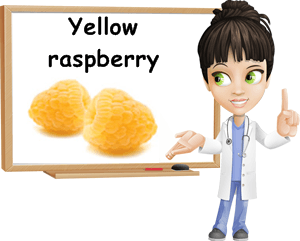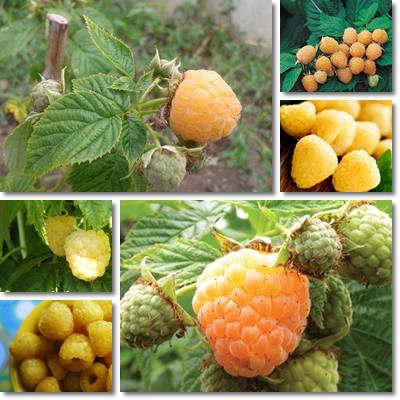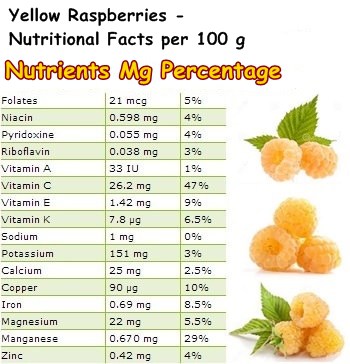Believe it or not, yellow raspberries are actually a variety of the common red raspberry. Although they differ in colour, yellow raspberries preserve the intense aroma and the delicate, sweet taste of red raspberries.
But why do some raspberry plants turn golden-yellow when ripe instead of red? The culprit is none other than the colour gene of the fruit which remains dormant (this is called a recessive gene), resulting in a fruit that lack the usual color pigments.
Because yellow raspberries are harder to find, they are usually more expensive than their red counterpart. If you find yellow raspberries are more to your liking vs the traditional pink-red variety, do not fear because they have the exact same season: yellow raspberries are available July through September in the Northern hemisphere. After all, they are essentially the same fruit, except for the fact they come in a different colour. The difference in color doesn’t affect the overall nutritional profile of the fruit, with one exception: vitamin A content. Other than this, yellow raspberries remain a healthy option and have just as many benefits as red ones.

About the Raspberry Plant and Fruit
Raspberry shrubs commonly have numerous small thorns and are extremely leafy. Tip: when picking raspberries, look behind the leaves because that is where the ripest, most delicious and succulent fruits tend to hide.
Raspberry shrubs are very fruitful so, at the end of a season, you may even have enough fruit left to make a few jars of delicious jam after enjoy fresh fruit throughout the season.
A single shrub can yield up to several kilograms of raspberries per season, provided it has sufficient sunlight and is watered daily.
If you can’t keep up with eating the fruit, just wash and freeze them on a spread out on a baking tray; once frozen, collect the fruit in a bag and put back in the freezer for storage.
You can use frozen raspberries for baking or to make smoothies and milkshakes with bananas or pear and sweetened with raw honey.
Do know that all raspberry varieties, including yellow ones, are invasive species so it is best to keep your shrubs trimmed so they won’t overwhelm adjacent plants or spread uncontrollably.
As I have already said, yellow raspberries are wonderfully sweet and juicy fruits with low acidity and pleasant fruity flavors.
They are great eaten fresh, but also make an unbelievable jam or whole fruit preserve. In addition to their unique, honey-sweet taste, yellow raspberries are also incredibly healthy.
What do yellow raspberries look like?
Yellow raspberries are made up of dozens of tiny individual droplets grouped together in a basket-like shape. There are fine hairs sticking out from all over, and each individual droplet contains one hard seed. The color of the ripe fruit is a beautiful, bright golden yellow and the fruit are extremely juicy and sweet. In yellow raspberries, the gene that causes the fruit to turn pink-red as they ripen is inactive, resulting in a discolored, yellow fruit instead of red.
What do yellow raspberries taste like?
Yellow raspberries taste different from red. Vs red which are both sweet and tart, yellow raspberries are straightforward sweet, with little to no acidity. The perfectly ripe fruit have a strong fruity scent, with a deep, sweet, honey-like flavor.
Best uses for yellow raspberries
- Consumed as fresh fruit
- Used to make fruit tea; you can also use the leaves to make yellow raspberry leaf tea
- Frozen and used as such, for cooking or for baking
- Pureed in smoothies, milkshakes and home-made ice cream
- Use as topping for breakfast yogurt, cereal, oatmeal (porridge), rice pudding etc.
- Used to make jam, whole fruit preserves and fruit sauces

Nutrition facts and health benefits Of Yellow Raspberries
Yellow raspberries are rich in vitamin C and various biologically active phytochemicals, natural compounds with potent antioxidant and anti-inflammatory effects. Antioxidants help protect cells from and repair damage produced by unstable molecules called free radicals. Cell damage causes inflammation in the body and mutagenic changes in cells, setting the scene for cancer development.
But yellow raspberries provide 26.2 mg (milligrams) of ascorbic acid for every 100 grams of fresh fruit which is close to 30% of the minimum recommended daily intake of the vitamin for the average adult. This is a generous amount and represents an important source of benefits for health, including antioxidant, anti-inflammatory and anticancer benefits.
The content of vitamin C in yellow raspberries is highest in the fresh fruit which should be eaten as soon as possible after being picked.
The first signs of over-ripeness in the fruit also signal a decline in their vitamin C content, taking away from the health benefits associated with the vitamin.
What further makes yellow raspberries healthy, and other raspberry colors too, according to BioFactors (2005;23), is the fact that the fruit have ten times more antioxidants than tomatoes and broccoli. With their incredible antioxidant content, yellow raspberries are considered to be a guardian of good health, helping reduce risks of chronic disease such as cancer.
Yellow raspberries contain important polyphenols with antioxidant and antiproliferative activities known as ellagitannins. Animal studies have shown ellagitannins get converted into a biologically active compound called Urolithin A with an anti-aging action. Ellagitannins such as ellagic acid also have scientifically proven anticancer properties.
Eating yellow raspberries regularly is a great way to preserve a youthful appearance and delay aging. Vitamin C in the fruit stimulates the production of collagen in the fruit for improved skin elasticity and antiaging benefits for the skin. Urolithin A, obtained from the conversion of ellagitannins by the gut microbiota, exerts systemic antiaging benefits.
However, know that antioxidants in food are affected by factors such as air, light and heat, including cooking heat. For example, while freezing tends to preserve the antioxidant content of the fruit relatively intact, cooking heat required to turn the fruit into jam or sauce destroys some antioxidants completely (e.g. vitamin C) or reduces their content significantly. At the same time, some antioxidants survive cooking heat with minimal losses.
Ideally, enjoy yellow and other raspberry colors fresh and get a high intake of beneficial antioxidants to both help protect cells from oxidative stress and repair cell and DNA damage.
The protective and reparative effects of antioxidants in the fruit contribute to benefits such as reduced inflammation levels in the body and provide protection against chronic disease.

With a good content of vitamin C, yellow raspberries stimulate the production of collagen, the main structural protein in the body. Different types of collagen provide structure to different organs and tissues, including skin, blood vessel walls, but also teeth and bones. Eating yellow raspberries not only contributes to skin elasticity for more youthful looking skin without wrinkles and fine lines, but is also good for teeth.
According to more recent studies, regular consumption of yellow raspberries can potentially help ease symptoms of depression and improve mood swings. And the reason why a handful of yellow raspberries may bring a smile to your face has to do with bioactive components in the fruit which act directly on the nervous system, regulating its activity.
Yellow and red raspberries, purple raspberries and also black raspberries are rich in dietary fiber. A serving of 100 g of the fresh fruit contains approximately 6.5 g of fiber which is 23% of daily fiber requirements for an adult.
Dietary fiber adds bulk to stools and stimulates contractions of the muscles of the digestive tract that help move food along, relieving constipation.
Not just this, dietary fiber from fresh fruit and vegetables bind to fat from food, limiting absorption which holds benefits for high cholesterol.
As far as the dietary mineral content of the fruit is concerned, the variety is a rich source of manganese, a powerful antioxidant that is part of the innate antioxidant defense system of the body. Manganese from yellow raspberries also holds benefits for fertility and bone density.
You can see in the nutrition table above that yellow raspberries have good amounts of copper, iron and magnesium, and a modest zinc content. Copper counteracts premature gray hair and iris discoloration. Iron boosts vitality and energy levels. Magnesium and zinc contribute to bone density.
In addition to this, yellow raspberries are a source of carotenoids, pigmented antioxidants with a range of benefits for health, including benefits for eyesight, skin health and the immune system. Eating yellow raspberries provides quick energy for the body to use from natural sugars as well as long-lasting energy from small amounts of B vitamins which combat tiredness and fatigue. The fruit is truly a healthy food, good for both physical and mental health.
